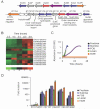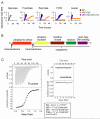Specificity of polysaccharide use in intestinal bacteroides species determines diet-induced microbiota alterations
- PMID: 20603004
- PMCID: PMC2900928
- DOI: 10.1016/j.cell.2010.05.005
Specificity of polysaccharide use in intestinal bacteroides species determines diet-induced microbiota alterations
Abstract
The intestinal microbiota impacts many facets of human health and is associated with human diseases. Diet impacts microbiota composition, yet mechanisms that link dietary changes to microbiota alterations remain ill-defined. Here we elucidate the basis of Bacteroides proliferation in response to fructans, a class of fructose-based dietary polysaccharides. Structural and genetic analysis disclosed a fructose-binding, hybrid two-component signaling sensor that controls the fructan utilization locus in Bacteroides thetaiotaomicron. Gene content of this locus differs among Bacteroides species and dictates the specificity and breadth of utilizable fructans. BT1760, an extracellular beta2-6 endo-fructanase, distinguishes B. thetaiotaomicron genetically and functionally, and enables the use of the beta2-6-linked fructan levan. The genetic and functional differences between Bacteroides species are predictive of in vivo competitiveness in the presence of dietary fructans. Gene sequences that distinguish species' metabolic capacity serve as potential biomarkers in microbiomic datasets to enable rational manipulation of the microbiota via diet.
Figures







References
-
- Backhed F, Ley RE, Sonnenburg JL, Peterson DA, Gordon JI. Host-bacterial mutualism in the human intestine. Science (New York, NY. 2005;307:1915–1920. - PubMed
-
- Bolam DN, Xie H, Pell G, Hogg D, Galbraith G, Henrissat B, Gilbert HJ. X4 modules represent a new family of carbohydrate-binding modules that display novel properties. The Journal of biological chemistry. 2004;279:22953–22963. - PubMed
-
- Collaborative Computational Project The CCP4 suite: programs for protein crystallography. Acta crystallographica. 1994;50:760–763. - PubMed
Publication types
MeSH terms
Substances
Grants and funding
LinkOut - more resources
Full Text Sources
Other Literature Sources
Molecular Biology Databases

